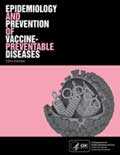About Meningococcal Vaccines
One of the Recommended Vaccines by Disease
There are 4 meningococcal vaccines available in the United States. Learn about the composition, types, immunogenicity, and efficacy of these vaccines, as well as view package inserts, below.
Types and Composition of Meningococcal Vaccines
Of the four meningococcal vaccines available in the United States, two are conjugate vaccines and two are recombinant protein vaccines. Meningococcal vaccines are also differentiated by the number of serogroups they provide protection against. Both recombinant protein vaccines are monovalent vaccines, meaning they are licensed to provide protection against one serogroup (serogroup B). In contrast, both conjugate vaccines provide protection against 4 serogroups (A, C, W, and Y), making them quadrivalent vaccines.
Meningococcal Conjugate Vaccines
Each 0.5-milliliter (mL) dose of Menactra® (Sanofi Pasteur) is formulated in sodium phosphate buffered isotonic sodium chloride solution to contain 4 micrograms (µg) each of meningococcal A, C, W, and Y polysaccharides conjugated to approximately 48 µg of diphtheria toxoid protein carrier. It is supplied as a liquid in a single-dose vial and does not contain a preservative or an adjuvant.
Each dose of Menveo® (GlaxoSmithKline) consists of two portions: 10 µg of lyophilized meningococcal serogroup A capsular polysaccharide conjugated to CRM197 and 5 μg each of capsular polysaccharide of serogroup C, W, and Y conjugated to CRM197 in 0.5 mL of phosphate buffered saline, which is used to reconstitute the lyophilized MenA component before injection. It does not contain a preservative or an adjuvant.
Serogroup B Meningococcal Vaccines
Each 0.5-mL dose of Bexsero® (GlaxoSmithKline) is formulated to contain 50 µg each of recombinant proteins Neisserial adhesin A (NadA), Neisserial Heparin Binding Antigen (NHBA), and factor H binding protein (fHbp), 25 µg of Outer Membrane Vesicles (OMV), 1.5 milligrams (mg) aluminum hydroxide (0.519 mg of Al3+), 3.125 mg sodium chloride, 0.776 mg histidine, and 10 mg sucrose at pH 6.4 – 6.7. Each dose contains less than 0.01 µg kanamycin (by calculation).
Each 0.5-mL dose of Trumenba® (Pfizer) is formulated to contain 60 µg each of two lipidated fHBP variants (total of 120 µg of protein), 0.018 mg of polysorbate 80, and 0.25 mg of Al³+ as AlPO4 in 10 millimolar (mM) histidine buffered saline at pH 6.0.
Helpful Terms
- Conjugate: A type of vaccine that joins a protein to an antigen in order to improve the protection the vaccine provides
- Recombinant: A type of vaccine where the protein antigen is put into a harmless virus or bacterium that then makes copies of the antigen that the immune system recognizes and creates protective antibodies against
Immunogenicity and Vaccine Efficacy
Today, meningococcal disease is at a historic low in the United States. Incidence of meningococcal disease has been declining in the United States since the 1990s, with much of the decline seen prior to routine use of meningococcal conjugate vaccines. In addition, serogroup B meningococcal disease has continued to decline even though vaccines were not available to help protect against it until the end of 2014. Among 11 through 19 year olds the incidence of meningococcal disease caused by serogroups C, Y, and W decreased (80%) since the meningococcal conjugate vaccine program was established for adolescents. Similar declines were not seen in age groups not routinely receiving conjugate vaccines. These data suggest meningococcal conjugate vaccines provide protection to those vaccinated, but do not provide protection to the larger, unvaccinated community through herd immunity.
As part of the licensure process, both meningococcal conjugate and serogroup B meningococcal vaccines demonstrated that they produce an immune response that suggests the vaccines are protective (summarized from package inserts below), but there are limited data available on how effective they are. With an uncommon disease like meningococcal disease, many people need to get a vaccine before its effectiveness can be measured on a large scale.
In studies demonstrating the efficacy:
- Menactra®
- Between 82% and 97% of adolescents vaccinated demonstrated a protective immune response one month after completing the series
- Between 74% and 89% of adults vaccinated demonstrated a protective immune response one month after completing the series
- Menveo®
- Between 75% and 96% of adolescents vaccinated demonstrated a protective immune response one month after completing the series
- Between 69% and 94% of adults vaccinated demonstrated a protective immune response one month after completing the series
- Bexsero®
- Between 63% and 94% of adolescents and young adults vaccinated demonstrated a protective immune response one month after completing the series
- Trumenba®
- Between 81% and 84% of adolescents and young adults vaccinated had a protective immune response one month after completing the series
Available data suggest that protection from meningococcal conjugate vaccines decreases in many adolescents within 5 years, which emphasizes the importance of the 16-year-old booster dose so that adolescents maintain protection during the ages when they are most at risk for meningococcal disease. Early data on serogroup B meningococcal vaccines suggest that protective antibodies also decrease fairly quickly after vaccination.
Package Inserts
Consult the following package inserts for proper storage and handing details, shelf life, and reconstitution instructions:
Related Pages
- Meningococcal Vaccine Information Statements
- Conjugate (English / Other Languages)
- Serogroup B (English / Other Languages)
- Pink Book’s Chapter on Meningococcal Disease
Epidemiology & Prevention of Vaccine-Preventable Diseases
- Page last reviewed: May 19, 2017
- Page last updated: May 19, 2017
- Content source:


 ShareCompartir
ShareCompartir
